Mobile App Development Process: A Complete Guide for Startups
Still trying to figure out how to turn your idea into a real app? You’re not alone. Many early-stage founders have a brilliant concept but no clear path to execution. As a tech expert trusted by startups and enterprises alike, we’re here to simplify the mobile app development process for you.
From defining your vision to launching a market-ready product, every stage—whether it’s app prototype development, UI/UX design, or backend coding—follows a proven framework. The app development steps we follow are designed to minimize guesswork, reduce costs, and accelerate time to market.
In this guide, we’ll walk you through the full app development procedure—from initial concept to final deployment—while covering tools like online Flutter app builders, best practices for app design and development, and key insights into every app development stage.
The global mobile application market is projected to reach $567.19 billion by 2030, growing at a CAGR of 13.4% from 2023 onwards.
Whether you’re planning to build a minimum viable product or a full-featured app, understanding the steps of app development can make or break your success. Let’s dive into how we at APPWRK build powerful, user-centric apps that scale—starting with a clear strategy and ending with a successful launch.
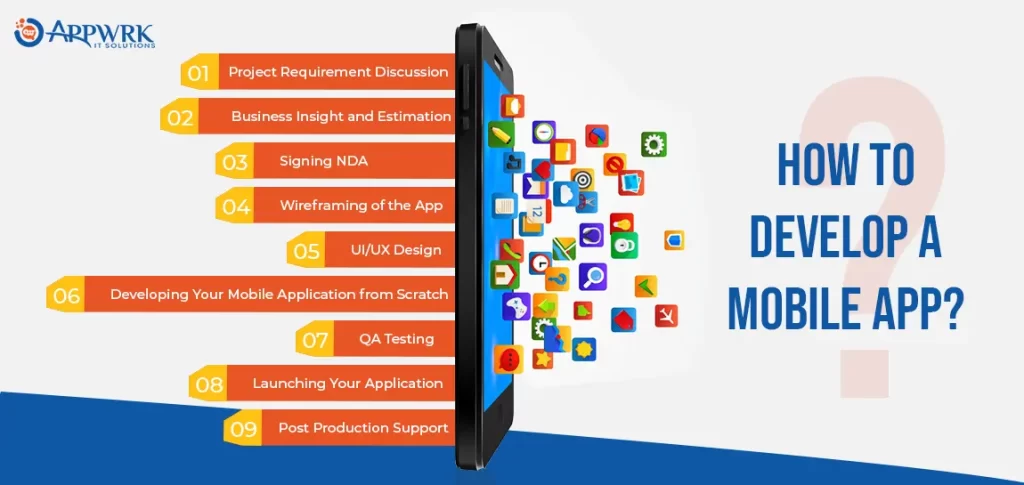
Table of contents
- Step 1: Project Requirement Discussion
- Step 2: Business Insight and Estimation
- Step 3: Signing NDA
- Step 4: Wireframing of the App
- Step 5: UI/UX Design
- Step 6: Backend, Frontend & Feature Integration
- Step 7: QA Testing
- Step 8: Launching Your Application
- Step 9: Post Production Support
- Mobile App Development Process: Frequently Asked Questions
- What are the key stages in the mobile app development process?
- Why is app prototype development a crucial part of the app development stages?
- Can you explain the mobile app development process step by step?
- What is the role of mobile software engineering in the mobile application development life cycle?
Step 1: Project Requirement Discussion
The first stage begins with a simple, casual call to understand your mobile app idea and see if we’re a good fit to move forward. This conversation helps clarify your app’s goals, target audience, and the problems you want to solve.
We discuss your expectations as a founder, whether you have a basic idea or have done in-depth research. This allows APPWRK to assess the app type and suggest the right technologies, databases, and solutions tailored to your needs.
Budget discussion follows, where we outline what features fit within your budget and how adjustments can enhance features or optimize performance. You’ll understand how changes in budget may impact your app.
Next, we define your project timeline, setting milestones and deadlines for each phase like planning, analysis, design, development, testing, and launch. This ensures full visibility of your project’s progress.
If you have reference apps, sharing them helps us better understand your vision regarding functionality, UI, and UX, and align our development approach accordingly.
Finally, APPWRK offers a free 30-minute consultation where you can discuss your goals, audience insights, and trending technologies with our mobile app experts at no cost.
Step 2: Business Insight and Estimation
At this stage of the development process, APPWRK dives deeper into the mechanics of your mobile app business. Let’s explore these essential components.
Competitive Advantage
Many businesses may have similar mobile apps already in the market. So, it’s critical to analyze your competitive advantage to ensure your app stands out and succeeds.
We begin by identifying who your competitors are and evaluating their strengths. We strategize ways to improve these areas, saving development time while maximizing your app’s potential returns.
Next, we identify gaps and pain points in competitor apps by evaluating user satisfaction and complaints. These gaps reveal new business opportunities for your app.
Once identified, we build solutions to address these gaps, ensuring your app delivers superior value and leaves a lasting impression on users.
Finally, our app development team creates a feature list aligned with these findings to guide your mobile app development.
Market Research
Market research is vital to understanding real market demands. It allows us to prioritize development based on current user interests and behaviors.
Key steps include creating customer personas, identifying user engagement areas, and mapping out communication strategies for your target audience.
This qualitative and quantitative research helps us better understand your customers and serves as a reference throughout the development process.
Building Revenue Strategy
No mobile app development is complete without planning for revenue generation. We analyze multiple monetization options like:
- In-app advertisements
- In-app purchases
- Paid apps
We incorporate your business insights and preferences to design a revenue model. Once finalized, we proceed to the legal documentation phase.
Step 3: Signing NDA
A Non-Disclosure Agreement (NDA) is critical for protecting your business and building trust between APPWRK and our clients.
Why NDA for your app idea?
Every company aims to safeguard its business information. The NDA ensures that all confidential details remain protected throughout the mobile app development process.
By signing the NDA, both parties agree to not disclose any sensitive information shared during the project to any third party.
What will you get in the project development agreement?
The Project Development Agreement includes:
- Approximate expenses
- Estimated timeline
- NDA terms
- Project termination conditions
Step 4: Wireframing of the App
The app development process moves to laying out the basic structure of your mobile app through wireframing.
What is a Wireframe?
A wireframe is a visual blueprint of your app’s structure and functionality. It focuses not on design, but on how your product works and how it will solve user problems.
Wireframes outline:
- User journey phases and actions
- Key features, objects, and screen elements
- Content hierarchy and surface content
- Screen transitions and navigation flow
With wireframes ready, it becomes easier to align stakeholders and present your concept to investors effectively.
Why is Wireframing Important?
Wireframes help visualize how your app will serve users and allow us to spot issues early before full development begins.
1. Visual Blueprint to Validate Your Idea
Wireframes turn your concept into a clear, actionable flow. You can analyze use cases, user interactions, and refine your product to better address user pain points.
2. Faster Iterations & Error Avoidance
Wireframing allows for quick modifications before major development starts. You can:
- Present wireframes to investors and collect feedback
- Modify features based on discussions
- Collaborate with team members on improvements
- Repeat until fully aligned with your vision
This helps avoid costly design mistakes later.
3. Saves Time in Design and Development
Wireframes provide a clear direction for UX/UI, reducing back-and-forth changes during development. Content creation becomes streamlined and well-organized, ensuring clarity for both design and development teams.
Instead of verbal explanations, wireframes serve as visual proof of your app’s flow and functionality.
Tools APPWRK uses for Wireframing
Business analysts at APPWRK uses advanced wireframing tools such as:
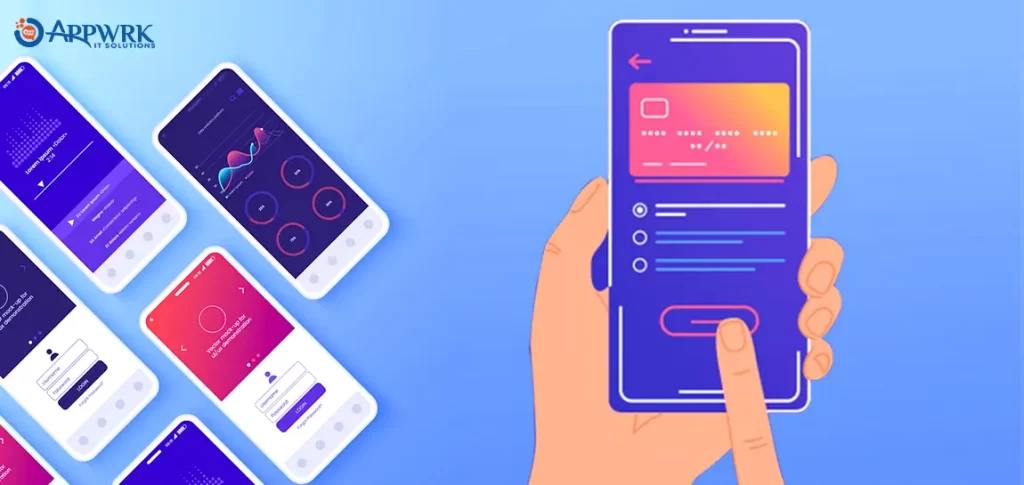
Step 5: UI/UX Design
With the completion of earlier stages, the tangible mobile app development process officially begins with UI/UX design. This phase gives life to your ideas and creates the foundation for user engagement and satisfaction.
What Do We Deliver During This Stage?
Our mobile application design and development process focuses on both user experience (UX) and user interface (UI) to ensure maximum usability, higher conversions, and long-term retention.
Here’s what you receive in this crucial phase of the app design and development process:
- Highlight critical information and make CTAs easily accessible for better user actions.
- Simplify design patterns to enable users to make quick decisions intuitively.
- Build a visual hierarchy so elements appear where users naturally expect them.
- Ensure the design is memorable, reducing cognitive load and improving user recall.
These elements play a major role across various steps of app development, helping users navigate your app effortlessly while increasing business outcomes.
How Much Does It Cost to Design an App?
The app design and development cost typically ranges from $10,000 to $30,000, depending on factors like:
- The desired features
- Complexity of UX/UI choices
- Size of the development team involved in the app development process
Proper investment in app prototype development and design during early app development stages ensures you avoid costly revisions later.
How This Fits Into the App Development Procedure
By focusing on a well-planned app prototype development, we ensure your product is validated before full development begins. This is a critical part of the broader app making process that saves time, improves quality, and provides a solid direction for subsequent app development steps.
Bonus for Founders: Online Flutter App Builder Integration
For clients interested in faster prototyping or MVPs, APPWRK also integrates online Flutter app builder tools during the app development procedure to speed up initial iterations while maintaining scalability for full-stack builds later
Step 6: Backend, Frontend & Feature Integration
Planning remains the necessary component in the mobile app development process. Now is the execution time. Here, actual development starts in which technologies play a pivotal role.
For Android development, APPWRK uses the following technologies:
| Programming Language | Kotlin |
| IDE | Android Studio |
| Database | SQLite, Realm |
| Tools | Android SDK, and Android NDK |
APPWRK uses the following technologies to develop complete iOS apps.
| Programming Language | Swift, Objective-C |
| IDE | XCode |
| Database | SQLite, Realm, CoreData |
| Tools | Xcode |
Basically, a mobile app consists of two integral parts: front-end development, API, and back-end development. In back-end development, we work on databases, API, back-end logic, and server-side objects for websites to perform efficiently. Further, our front-end developers create features and elements visible to the users.
Step 7: QA Testing
Quality assurance specialists at APPWRK check developed mobile apps under the following standards:

Performance testing:
We test if the mobile app works well for a high number of users and peak demand times. It is to ensure that:
- The mobile app screen loads fast.
- Mobile App responds satisfactorily to user requests.
- Mobile app making the best use of available network bandwidth.
Security testing
Indeed, security is the most critical aspect of the mobile app development process. Our security experts protect your mobile app from any potential vulnerabilities.
We test every entry point, whether at the back-end or front-end, like APIs, login places, etc. It protects your mobile app from hacking and data leakages.
UX/UI testing
UX/UI testing matters the most to leave a lasting impression on the users, make them repeat visitors, and get maximum conversions. We confirm to fill in any loopholes in the mobile app design and give your users a flawless experience.
In this, we match user interactions with the intended design by the team. It covers visuals, color schemes, navigation, highlighting essential elements, etc.
Cross-platform testing
As mobile devices keep changing every other day, testing your mobile app with device compatibility is vital. Our mobile app professionals test your app for the latest feature additions in the industry. Not only this, we test the finally developed app for existing platforms, Android and iOS.
Step 8: Launching Your Application
The final and decisive phase in the mobile app development process is the official launch of your app on live platforms, making it fully accessible to your users.
How to Publish the App on the App Store and Play Store?
APPWRK assists clients end-to-end in uploading their applications to both the App Store and Play Store without charging any additional costs. Our team handles the entire app deployment procedure to ensure a smooth launch.
What Does APPWRK Need from the Client’s Side?
To publish your app, APPWRK requires developer account credentials from your side. Once these credentials are shared, our team takes care of the entire app publishing process professionally.
Is It Easy to Publish an Application?
Yes. Experienced team at APPWRK handles the complete process, assisting you from submission to final approval, ensuring your application is fully operational and available to your target audience.
Step 9: Post Production Support
Even after the app goes live, APPWRK continues to provide full post-production support to ensure smooth operation and ongoing improvements.
The first few weeks post-launch are critical for monitoring performance, collecting user feedback, and making any necessary adjustments or updates to enhance your app’s stability and user experience.
During this phase, APPWRK collects valuable data insights and learnings, helping fine-tune the app to keep it on the growth track and aligned with your evolving business goals.
Mobile App Development Process: Frequently Asked Questions
What are the key stages in the mobile app development process?
The mobile app development process includes stages like project discussion, app prototype development, UI/UX design, coding, testing, launching, and post-production support. Each phase ensures your mobile application design and development meets business goals effectively.
How do I start the app making process for my business?
You can start by consulting a professional mobile app development company unlike APPWRK, that guides you through each phase of the app development procedure, from idea validation to final deployment and scaling.
Why is app prototype development a crucial part of the app development stages?
App prototype development allows you to validate your idea early, visualize user flows, and fine-tune features before entering full-scale app design and development. This avoids costly revisions later.
Can an online Flutter app builder speed up my app development process?
Yes, an online Flutter app builder can accelerate initial prototyping and MVP builds. However, for complete mobile application design and development, custom development remains essential for scalability, performance, and customization.
What are the cost factors involved in the mobile app development process?
Costs vary based on app complexity, UX/UI design, app prototype development, required features, platform choices, and the size of the team executing your app development procedure.
Can you explain the mobile app development process step by step?
Yes. The mobile app development process step by step includes:
- Project Discussion
- Requirement Analysis
- Wireframing
- App prototype development
- UI/UX Design
- Coding & Backend Development
- Testing
- Deployment
- Post-launch Support
What is the role of mobile software engineering in the mobile application development life cycle?
Mobile software engineering plays a central role in the mobile application development life cycle by ensuring coding best practices, optimized architecture, scalability, security, and efficient backend systems across all app development steps.
Can you provide a mobile app development process example?
Yes, we share complete case studies and mobile app development process examples that showcase how we took clients from initial idea through full app design and development, launch, and growth stages.
Do you offer a mobile app development process pdf or steps ppt for client reference?
Yes. We offer both mobile app development process pdf guides and steps ppt documents for our clients. These resources outline the full app development procedure for better planning and smoother collaboration.
What is the difference between app design and development?
App design focuses on crafting the interface, navigation, and user experience, while app development involves coding, backend integration, security, and making the app fully functional across platforms.
About The Author


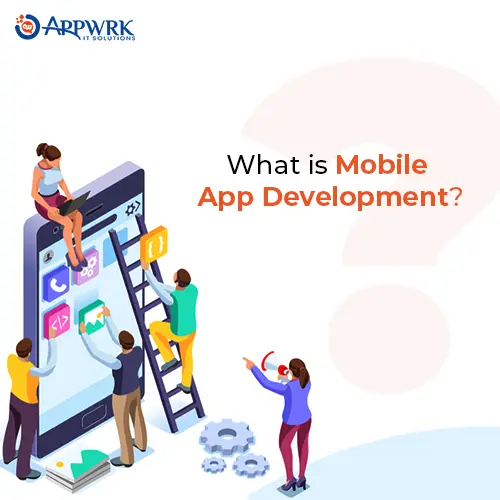
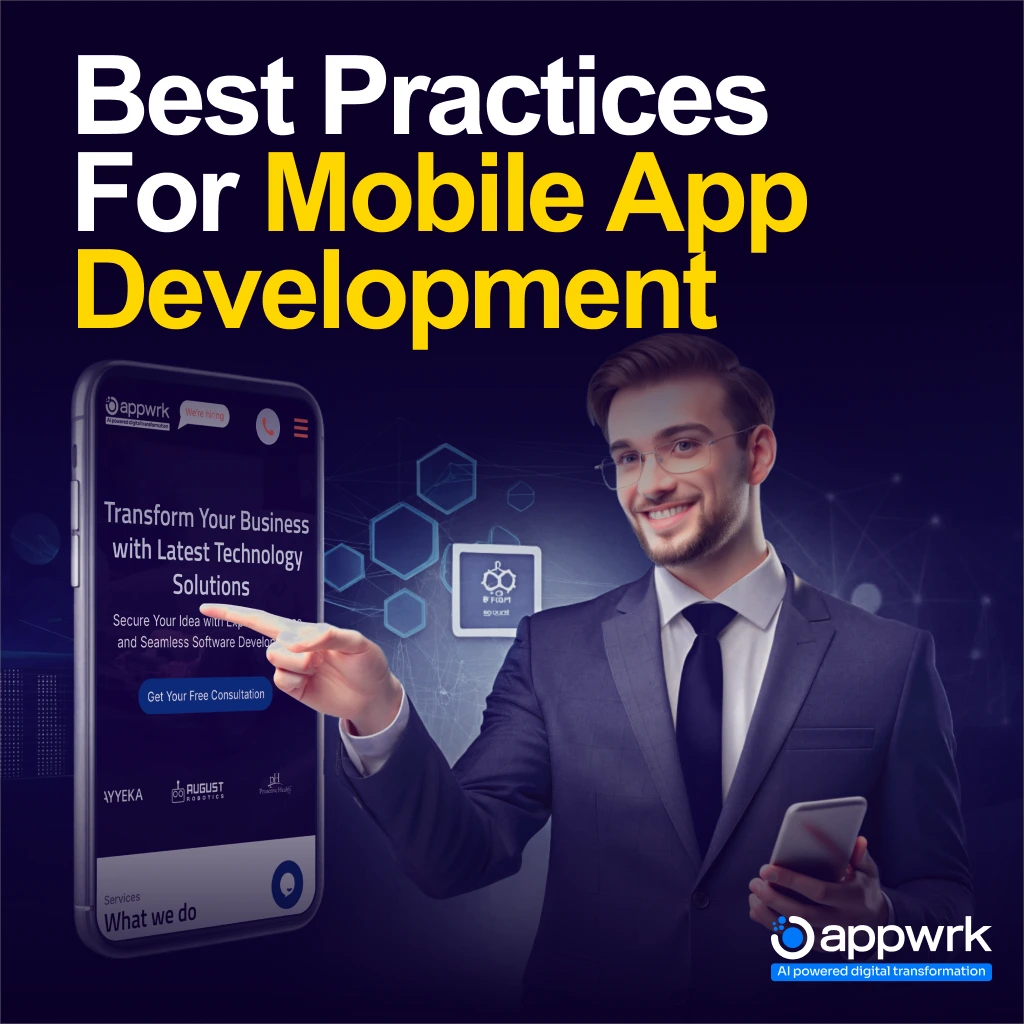
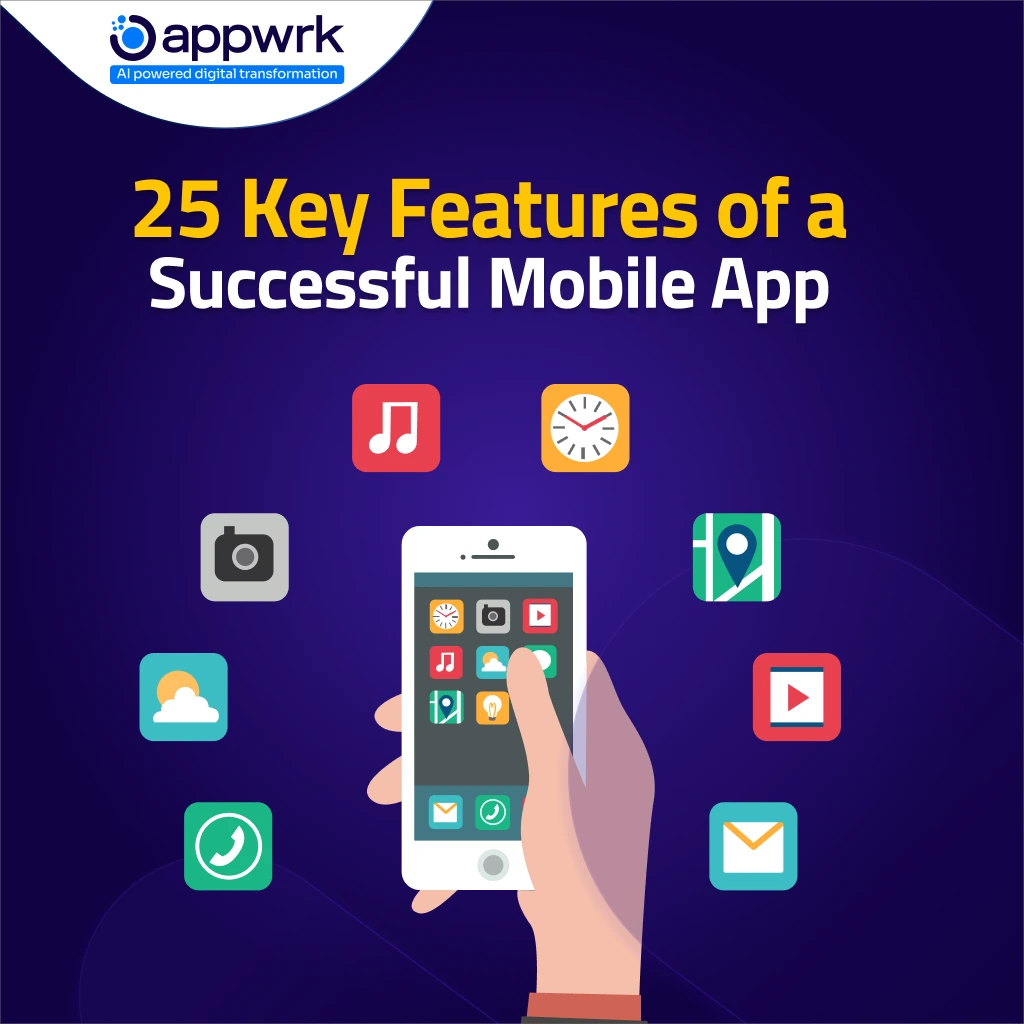


 Free Quote
Free Quote
















































